International Journal of Modern Education and Computer Science @ijmecs
Статьи журнала - International Journal of Modern Education and Computer Science
Все статьи: 1123
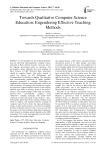
Towards Qualitative Computer Science Education: Engendering Effective Teaching Methods
Статья научная
An investigation into the teaching method(s) that can effectively yield qualitative computer science education in Basic Schools becomes necessary due to the Nigerian government policy on education. The government’s policy stipulates that every graduate of Basic Schools or UBE (Universal Basic education) should be computer literate. This policy intends to ensure her citizens are ICT (Information and Communication Technology) compliant. The foregoing thus necessitatesthe production of highly qualified manpower―grounded in computer knowledge―to implement the computer science education strand of the UBE curriculum. Accordingly, this research investigates the opinion of computer teacher-trainees on the teaching methods used while on training. Some of the teacher-trainees―that taught computer study while on teaching practice―were systematically sampled using “Purposive” sampling technique. The results show consensus in male and female teacher-trainees’ views; both gender agreed that all the teaching methods used, while on training, will engender effective teaching of computer study. On the whole, the mean performance ratings of male teacher-trainees were found to be higher than that of females. However, this is not in accord with the target set by Universal Basic Education Commission which intends to eliminate gender disparity in the UBE programme. The results thussuggestthe need for further investigation using larger sample.
Бесплатно
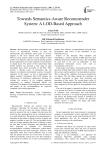
Towards Semantics-Aware Recommender System: A LOD-Based Approach
Статья научная
Recommender systems have contributed to the success of personalized websites as they can automatically and efficiently select items or services adapted to the user's interest from huge datasets. However, these systems suffer of issues related to small number of evaluations; cold start system and data sparsity. Several approaches have been explored to find solutions to related issues. The advent of the Linked Open Data (LOD) initiative has spawned a wide range of open knowledge bases freely accessible on the Web. They provide a valuable source of information that can improve conventional recommender systems, if properly exploited. In this paper, we aim to demonstrate that adding semantic information from LOD enhance the effectiveness of traditional collaborative filtering. To evaluate the accuracy of the semantic approach, experiments on standard benchmark dataset was conducted. The obtained results indicate that the accuracy and quality of the recommendation are improved compared with existing approaches.
Бесплатно
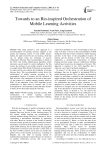
Towards to an Bio-inspired Orchestration of Mobile Learning Activities
Статья научная
This paper presents a new approach to a recommendation of learning activities adapted to the spatial and temporal context of each mobile learner. Indeed, the path traveled by the user during a field trip can be guided using the technique of passive collaborative filtering. This recommendation is based on the ACO (Ant Colony Optimization) algorithm, which represents a good model for swarm intelligence. For this reason, the structure of our mobile scenario is described as a graph where POIs (Point Of Interest) are represented by nodes and the arcs indicate the probability of moving between them. This recommendation system allows the orchestration of mobile learning according to the geographical location of learners and the historical of their activities. Our contribution is devised in three parts: (1) the creation of a mobile learning scenario based on POIs, (2) the adaptation of the ACO algorithm for the orchestration of paths taken by learners, and (3) the development of a recommender system that helps learners to better choose their paths during the field trip.
Бесплатно
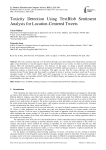
Toxicity Detection Using TextBlob Sentiment Analysis for Location-Centered Tweets
Статья научная
The toxic comment detection over the internet through social networking posts found hatred comments and apply certain limitations to stop the negative impact of that information in our society. In order to perform sentiment analysis, NLP text classification approach is very effective. In this paper, we design a specific algorithm using Convolution Neural Network (CNN) approach and perform TextBlob sentiment analysis to evaluate the polarity and subjectivity analysis of posted tweets or comments. This paper can also filter the tweets collected over different locations formed Twitter dataset and then model is evaluated in terms of accuracy, precision, recall and f1-score as calculated results of 0.984, 0.887, 0.905 and 0.895 respectively for the analysis of toxic/non-toxic comment identification. Hence, our algorithm utilized NLTK and TextBlob libraries and suggests that the analyzed post can be recommended to the others or not.
Бесплатно
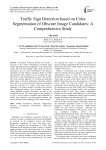
Статья научная
Automated Vehicular System has become a necessity in the current technological revolution. Real Traffic sign detection and recognition is a vital part of that system that will find roadside traffic signs to warn the automated system or driver beforehand of the physical conditions of roads. Mostly, researchers based on Traffic sign detection face problems such as locating the sign, classifying it and distinguishing one sign from another. The most common approach for locating and detecting traffic signs is the color information extraction method. The accuracy of color information extraction is dependent upon the selection of a proper color space and its capability to be robust enough to provide color analysis data. Techniques ranging from template matching to critical Machine Learning algorithms are used in the recognition process. The main purpose of this research is to give a review based on methods and framework of Traffic Sign Detection and Recognition solution and discuss also the current challenges of the whole solution.
Бесплатно
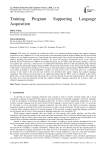
Training Program Supporting Language Acquisition
Статья научная
This study was conducted to evaluate the effects of a parenting training program that supports language acquisition in early childhood. To reveal such an effect, an experimental research design including pre-test-post-test and retention test was applied respectively. Experimental and control groups were formed with the parents of 4-6 years old children attending pre-school education institutions. To assess the language development levels of the children, Peabody Picture-Vocabulary Test (PPVT) was applied during the pre-test phase; after the parental training, a post-test was applied; and a year later, a retention test was implemented alternately. Parents in the experimental group evaluated the program after the Parental Support Program (PSP). The personal characteristics of the study group and the opinions of the parents evaluating the training have been shown by using the frequency and percentages. Whether PPVT and PSP scores differ according to socio-demographic variables was analyzed by t-tests. In the end, there was a significant increase in the results of the post-test and retention test performed after parent training that supports language acquisition. This increase has been found to be significantly higher than the PPVT scores of children in the control group. Thus, we have determined that the parents have a positive attitude towards the training program. The results of the study also reveal that parenting training that supports children's language acquisition has a positive effect on children's language development.
Бесплатно
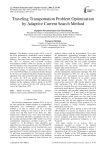
Traveling Transportation Problem Optimization by Adaptive Current Search Method
Статья научная
The adaptive current search (ACS) is one of the novel metaheuristic optimization search techniques proposed for solving the combinatorial optimization problems. This paper aimed to present the application of the ACS to optimize the real-world traveling transportation problems (TTP) of a specific car factory. The total distance of the selected TTP is performed as the objective function to be minimized in order to decrease the vehicle’s energy. To perform its effectiveness, four real-world TTP problems are conducted. Results obtained by the ACS are compared with those obtained by genetic algorithm (GA), tabu search (TS) and current search (CS). As results, the ACS can provide very satisfactory solutions superior to other algorithms. The minimum total distance and the minimum vehicle’s energy of all TTP problems can be achieved by the ACS with the distant error of no longer than 3.05%.
Бесплатно
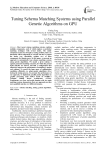
Tuning Schema Matching Systems using Parallel Genetic Algorithms on GPU
Статья научная
Most recent schema matching systems combine multiple components, each of which employs a particular matching technique with several knobs. The multi-component nature has brought a tuning problem, that is to determine which components to execute and how to adjust the knobs (e.g., thresholds, weights, etc.) of these components for domain users. In this paper, we present an approach to automatically tune schema matching systems using genetic algorithms. We match a given schema S against generated matching scenarios, for which the ground truth matches are known, and find a configuration that effectively improves the performance of matching S against real schemas. To search the huge space of configuration candidates efficiently, we adopt genetic algorithms (GAs) during the tuning process. To promote the performance of our approach, we implement parallel genetic algorithms on graphic processing units (GPUs) based on NVIDIA’s Compute Unified Device Architecture (CUDA). Experiments over four real-world domains with two main matching systems demonstrate that our approach provides more qualified matches over different domains.
Бесплатно
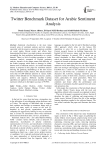
Twitter benchmark dataset for arabic sentiment analysis
Статья научная
Sentiment classification is the most rising research areas of sentiment analysis and text mining, especially with the massive amount of opinions available on social media. Recent results and efforts have demonstrated that there is no single strategy can mutually accomplish the best prediction performance on various datasets. There is a lack of existing researches to Arabic sentiment analysis compared to English sentiment analysis, because of the unique nature and difficulty of the Arabic language which leads to shortage in Arabic dataset used in sentiment analysis. An Arabic benchmark dataset is proposed in this paper for sentiment analysis showing the gathering methodology of the most recent tweets in different Arabic dialects. This dataset includes more than 151,000 different opinions in variant Arabic dialects which labeled into two balanced classes, namely, positive and negative. Different machine learning algorithms are applied on this dataset including the ridge regression which gives the highest accuracy of 99.90%.
Бесплатно
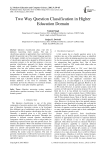
Two Way Question Classification in Higher Education Domain
Статья научная
Question classification plays vital role in Question Answering (QA) systems. The task of classifying a question to appropriate class is performed to predict the question type of the natural language question. In this paper, initially we have presented a brief overview of classification approaches adapted by different question answering systems so far and then propose a two-way question classification approach for higher education domain which not only identifies focus word and question class but also reduces answer search space within corpus comprise of question-answer pair, adding to the classification accuracy. For precise semantic interpretation of domain keywords, a domain specific dictionary is constructed which primarily have four domain word type. Classified features are built upon domain attributes in the form of constraints. The experiment proved the efficiency for restricted domain, even though we used quite simplistic approach.
Бесплатно
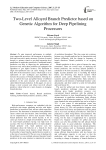
Two-Level Alloyed Branch Predictor based on Genetic Algorithm for Deep Pipelining Processors
Статья научная
To gain improved performance in multiple issue superscalar processors, the increment in instruction fetch and issue rate is pretty necessary. Evasion of control hazard is a primary source to get peak instruction level parallelism in superscalar processors. Conditional branch prediction can help in improving the performance of processors only when these predictors are equipped with algorithms to give higher accuracy. The Increment in single miss-prediction rate can cause wastage of more than 20% of the instructions cycles, which leads us to an exploration of new techniques and algorithms that increase the accuracy of branch prediction. Alloying is a way to exploit the local and global history of different predictors in the same structure and sometimes also called hybrid branch prediction. In this paper, we aim to design a more accurate and robust two-level alloyed predictor, whose behavior is more dynamic on changing branch direction.
Бесплатно
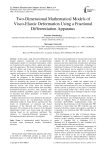
Статья научная
In this paper, using fractional differential and integral operators, constructed are two-dimensional mathematical models of viscoelastic deformation, which are characterized by memory effects, spatial non-locality, and self-organization. The fractal rheological models by Maxwell, Kelvin and Voigt, their structural properties and the influence of the fractional integro-differential operator on the process of viscoelasticity are investigated. Using the Laplace transform method and taking into account the properties of the fractional differential apparatus, analytical relations are obtained in the integral form for describing the stresses of generalized two-dimensional fractional-differential rheological models by Maxwell, Kelvin, and Voigt. Since the fractional-differential parameters of fractal models allow describing deformation-relaxation processes more perfectly than traditional methods, algorithmic aspects of identification of structural and fractal parameters of models are presented in the work. Explicit expressions have been obtained to describe the deformation process for one-dimensional fractional-differential models by Voigt, Kelvin, and Maxwell. The results of identification of structural and fractal parameters of the Maxwell and Voigt models are presented. The estimates of the accuracy of the obtained identification results were found using the statistical criterion based on the correlation coefficient. The influence of fractional-differential parameters on deformation-relaxation processes is investigated.
Бесплатно
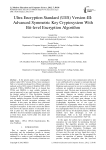
Статья научная
In the present paper a new cryptographic method called UES Version-III has been introduced. Nath et al recently developed few efficient encryption methods such as UES version-I, Modified UES-I, UES version-II, TTJSA, DJMNA Nath et. al showed that TTJSA and DJMNA is most suitable methods to encrypt password or any small message. The name of the present method is Ultra Encryption Standard Version-III. It is a Symmetric key Cryptosystem which includes multiple encryption, bit-wise randomization, new advanced bit-wise encryption technique with feedback. In this paper, the authors have performed encryption entirely at the bit-level to achieve greater strength of encryption. In the result section the authors have shown the spectral analysis of encrypted text as well as plain text. The spectral analysis shows that UES-III is free from standard cryptography attack such as brute force attack, known plain text attack and differential attack.
Бесплатно
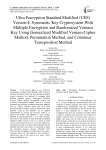
Статья научная
In the present paper a new combined cryptographic method called Modified UES Version-I has been introduced. Nath et al. have already developed several symmetric key methods. It combines three different methods namely, Generalized Modified Vernam Cipher method, Permutation method and Columnar Transposition method. Nath et al recently developed few efficient combined encryption methods such as TTJSA, DJMNA where they have used generalized MSA method, NJJSAA method and DJSA methods. Each of the methods can be applied independently to encrypt any message. Nath et. al showed that TTJSA and DJMNA is most suitable methods to encrypt password or any small message. The name of this method is Ultra Encryption Standard modified (UES) version-I since it is based on UES version-I developed by Roy et. al. In this method an encryption key pad in Vernam Cipher Method also the feedback has been used which is considered to make the encryption process stronger. Modified UES Version-I may be applied to encrypt data in any office, corporate sectors etc. The method is most suitable to encrypt any type of file such as text, audio, video, image and databases etc.
Бесплатно
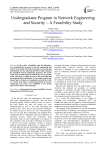
Undergraduate Program in Network Engineering and Security – A Feasibility Study
Статья научная
In this article, a feasibility study for initiating a new undergraduate program in network engineering and security is presented. The study was based on surveying and analyzing the current and projected future market demand for specialized network engineering graduates. The results of the study concluded that the demand for such a specialty in the work place is rapidly growing as the networking and telecommunication technologies are becoming essential and integral parts of about any organization around the world. As a result of the study, a pioneering program of network engineering and security was established at the Jordan University of Science and Technology.
Бесплатно
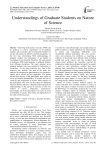
Understandings of Graduate Students on Nature of Science
Статья научная
Knowing about nature of science (NOS) and its products is a basic requirement of all graduate students and researchers due to being both members of society and experts on different scientific disciplines. As the first step, determining NOS understandings of graduate students has importance to go further in developing current situation. Therefore, this study aimed to determine NOS understandings of graduate students from different disciplines. The study included seven graduate students who were enrolled in universities as researchers. As the data collection way, face-to-face interview was utilized. The data of the study was analyzed by assigning the participants to four categories; expert, naive, mixed and not applicable. The results showed that majority of the participants were expert on social and cultural embeddedness of science and role of creativity and imagination in science while majority of the participants were naive on the aspects of “hierarchy between theories and laws”. Majority of them had mixed understandings on the aspects of existence of only one method in science, subjectivity, tentativeness. Interestingly, all of the participants were naive in terms of definition of science. The results and implications of the study will be discussed..
Бесплатно
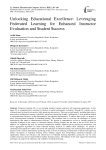
Статья научная
Federated Learning (FL) is an emerging machine learning approach with promising applications. In this paper, FL is comprehensively examined in relation to teacher performance evaluation. Through FL, teachers can be evaluated based on data-driven metrics while preserving data privacy. There are several benefits, including data privacy preservation, collaborative learning, scalability, and privacy-preserving insights. Additionally, it faces problems related to communication efficiency, system heterogeneity, and statistical heterogeneity. To address these issues, we propose a novel clustering-based technique in federated learning. The technique aims to overcome the challenges of system heterogeneity and improve communication efficiency. We provide a comprehensive review of existing research on clustering techniques in the context of federated learning, offering insights into the state of the art in this field. In addition, we emphasize the need for advanced compression methods, enhanced privacy-preserving mechanisms, and robust aggregation algorithms for future federated learning research. To address these challenges, we present a clustering-based approach to address the merits and challenges of federated learning The clustering-based approach we propose in this research demonstrates promising results in terms of reducing communication overhead and improving model convergence in federated learning. These findings suggest that incorporating clustering techniques can significantly enhance the efficiency and effectiveness of federated learning algorithms, paving the way for more scalable and privacy-preserving distributed machine learning systems. The findings of this study suggest that clustering techniques can improve the efficiency and scalability of federated learning.
Бесплатно
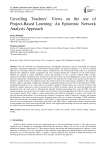
Статья научная
The role of teachers in facilitating learning is undoubtedly important as they are responsible for selecting appropriate instructional approaches. Project-Based learning (PrBL) has gained recognition as an effective teaching approach as it encourages students to think critically, collaboratively, and systematically. PrBL refers to an educational approach that emphasizes student engagement and active learning through the completion of real-world projects. Students are required to acquire information, search, and experiment to solve a specific problem. PrBL is largely adopted by the higher educational level. Limited use in primary schools has been highlighted by much research. The decision to adopt such a method depends on several factors. The main drivers to make such a decision are the teachers’ preference and the readiness for support from the school. The location of the school largely contributes to the readiness, facilities, support, and quality of education. This paper examines the teachers’ point of view on the utilization of PrBL. Comparing the points of view of the teachers who taught in different locations allows us to observe the factors that should be carefully addressed in order to promote the use of PrBL in primary schools. By using both qualitative and quantitative data, this study aims to understand the potential drawbacks preventing from using the PrBL. The data mining techniques were used to discover insights from both types of data including Epistemic Network Analysis (ENA) and sequence mining. ENA employs various mathematical and statistical techniques to analyze and visualize the network structure and dynamics. It can measure the strength of connections, identify central key concepts, and compare the differences in the structure between groups. Sequence mining allows us to observe the pattern of PrBL utilization. The results showed that even though teachers viewed PrBL as a useful approach, not many of them are using it. Also, there are some inconsistencies of knowledge on the steps in the PrBL process. Additionally, teachers often mentioned several problems they faced when using the PrBL. Hence, extra support and knowledge provision are needed, especially for schools located in suburban and rural areas.
Бесплатно
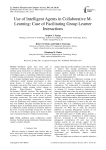
Статья научная
Intelligent agents have been used in collaborative learning. However, they are rarely used to facilitate group interactions in collaborative m-learning environments. In view of this, the paper discusses the use of intelligent agents in facilitating collaborative learning in mobile learning environments. The paper demonstrates how to design intelligent agents and integrate them in collaborative mobile learning environments to allow group learners to improve their levels of group knowledge construction. The design was implemented in a collaborative mobile learning system running on Modular Object-Oriented Dynamic Learning Environment (Moodle) platform. The application was used in some experiments to investigate the effects of those facilitated interactions on the level of group knowledge construction. The results showed improved levels of group knowledge construction in instances where the facilitations were enabled compared to where they were disabled. The paper concludes that the use of intelligent agents in facilitating learner group interactions in collaborative mobile learning environments improves the levels of group knowledge construction. For future work, the use of intelligent agents can be tested in other areas of group interactions to enhance group learning.
Бесплатно
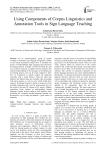
Using Components of Corpus Linguistics and Annotation Tools in Sign Language Teaching
Статья научная
As an interdisciplinary group of people working on automatic sign language recognition, authors of the article developed concept how to facilitate the process of understanding Sign Language (SL) utterances by hearing learners. Concept is based on Polish SL, and was created in response to signals from the students who indicate understanding of SL messages as the hardest part of learning process, but can be easily adapted to other SLs. In comparison to speech corpora, SL databases constitute only a small fraction. From the other side thanks to the Internet there are available video recordings with native-signers, as well as tools which enable their analysis. Developed concept is based on using one of the available annotation tools used by professionals all over the world to describe SL corpora in SL classes. Making annotations helps students in understanding foreign language, corpora analysis helps to find objective rules governing SL, computer assisted language learning can be attractive way of study and Internet – great source of materials.
Бесплатно

